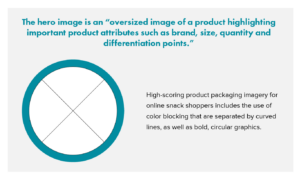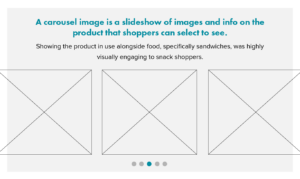Improving Your Visual Brand Performance Digitally
With online grocery sales predicted to grow by 21% in 2022, the market for digital grocery shopping is booming. As the pandemic fuels the transition into eCommerce, opportunities for improving your visual brand’s performance online arise. Companies look for their products to visually appeal to consumers because it can attract consumer attention to the product. Visual performance can be the tipping point in shoppers’ add-to-cart decision making. As such, optimizing your packaging and investing in visual performance initiatives should be prioritized in your marketing strategies.
Chip Performance Case Study
Moving forward, this means understanding and measuring what visuals work best for your product in the digital landscape. A recent Vizit Chip Report provided insights on what packaging and visual techniques best drive consumer engagement. The report tells us that Ritz out-performed other popular chip brands in imagery and consumer engagement – the brand’s high-performance score was driven by many factors, including the quality of images, hero images, and carousel images.
Packaging imagery and quality of image design are major components of consumer engagement. High-scoring product packaging imagery for online snack shoppers includes the use of color blocking that are separated by curved lines, as well as bold, circular graphics. This bold eye-catching technique can attract consumer attention and drive consumer engagement. Along with the design, the quality of the image is just as important. According to Salsify, 30% of U.S. shoppers say they will not purchase a product if images are missing or low quality
The hero image is an “oversized image of a product highlighting important product attributes such as brand, size, quantity and differentiation points.” The purpose of a hero image is to display relevant information digitally, rather than conventional store techniques. The report found that product hero imagery with quantity and flavor badging, specifically vertical badges along the right side of the image, are visually engaging for shoppers. Good examples of brands that perform well in this area are Ruffles and Lay’s. Chip Multi-Packs rank low in this area due to the limited contrast between the product visual and packaging design.

A carousel image is a slideshow of images and info on the product that shoppers can select to see. One example of highly engaged carousel content is showing the chip without packaging so the shopper can see the texture of the chip. This is particularly impactful, as showing the texture can attract consumer attention by demonstrating how the product appears differentiated from others. Another technique that heightened user engagement was images with chips pictured alongside food and meals. Showing the product in use alongside food, specifically sandwiches, was highly visually engaging to snack shoppers.

How can your brand increase conversion rates on eCommerce sites?
As we can tell from the chip case study, prioritizing your visual brand performance is key, as consumers will avoid brands that they don’t find visually appealing. So how can you improve your visual engagement game?
First, consider how you can do some A/B testing with your imagery. A/B testing compares two versions of a marketing strategy to measure the difference in product performance. Knowing which visualization works better among shoppers will grow engagement.
Another important design strategy is ensuring your brand uses high-quality informative imagery. High-quality images are important in managing your brand perception. In advertising, photo imagery will be the first thing a shopper experiences, as people are driven visually. Poor image quality reflects badly on you as a business, leading to the assumption that if your business is cheap, then your products could also be poor quality. This also means avoiding using cheesy stock photos. Customers want to feel that real people are using your product. Creating high-quality imaging with realistic components will increase engagement.
Finally, tracking all analytics is integral to measuring your success. Businesses will need to know what their strengths and weaknesses are within marketing and advertising which means implementing technology and computer systems to facilitate data measurements. Knowing consumer behavior and decision making inside and out will help businesses develop innovative marketing strategies. With this data, improving your visual brand is not only more effective – it more accurately speaks to your customers as well.
Looking Forward
Learning how to approach improving your visual brand image is imperative to drive eCommerce sales forward. This means developing popular imaging in order to establish a favorable brand perception and reputation. As the grocery world becomes more digitized, making sure your marketing strategies are evolving with technology will be crucial.
Subscribe to Clarkston's Insights
Contributions by Leah Harding



